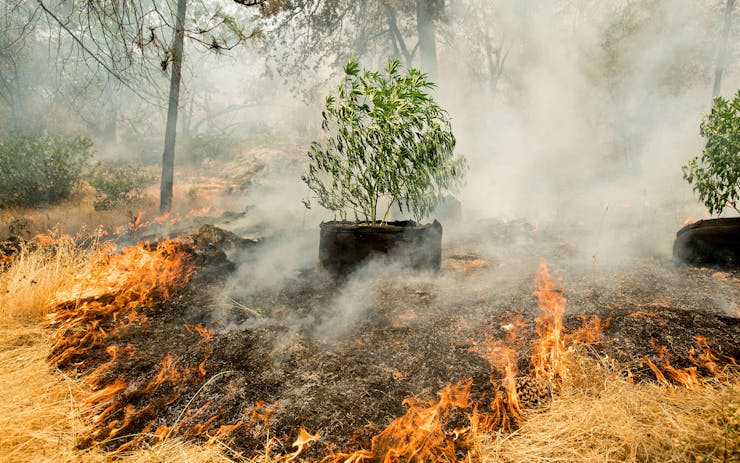As we head into the heart of wildfire season (August-September), growers in California in particular are on high alert after the disastrous wildfires of the past several years.
Julia Jacobson and her husband Samuel Ludwig of Aster Farms lost their cannabis crop in the Mendocino Complex Fire in 2018. “If you live in California, the wildfires will touch you in some way, somehow, at some point. As much as you can prepare, there is no way to truly anticipate what the experience is like, how terrifying nature can be.”
If a wildfire comes, cannabis farms near it will have to decide whether to destroy their crop. Bud can still get tainted by airborne toxins like pesticides, ash, soot, insulation, fire retardant, building materials, and more, and would be a danger to consumers.
When it’s necessary to destroy smoke-stressed plants
Cannabis in the seed stage may be fine and clean if toxic ash has not been introduced into the soil. Plants in the vegetative state can escape damage if toxins haven’t impacted their root systems.
Unfortunately, wildfire season tends to come when outdoor cannabis is in its reproductive (flowering) cycle, which is the most vulnerable time for contamination. Resinous flowers exposed to smoke from wildfires may be coated with dangerous toxins and foreign material—soot, hair, insects, excreta, or other adulterants.
According to Nelson Lindsley, cultivator, consultant, and owner of Poetry of Plants, when that happens, “You might as well start over.”
Farmers may not want to keep bud impacted by smoke because its growth and cannabinoid levels may be stunted. Studies comparing cannabinoid levels between smoke-stressed and control cannabis crops have yet to be published, but according to Lydia Abernethy, Director of Cultivation Science at Steep Hill, we do know that high levels of smoke can reduce UV rays, which promote important processes key to the growth of a plant, like photosynthesis, stomatal conductance, and transpiration.
“Plants choked by smoke may finish faster or produce greater defensive compounds [e.g. phytochemicals] in response to stress,” says Abernethy.
And the threat of wildfire damage to crops reaches farther than many assume. An alarming 2018 study on wildfires found that pollutants released by wildfires can affect crop and vegetation growth that’s hundreds of kilometers from the fire impact zone.
How to rule out tainted bud
Testing is better than judging on sight, but it can still prove complicated.
False-positive and false-negative results are common with wildfire-related contamination. Cannabis that is downwind from burning crops treated with pesticides may become contaminated. Traces found in testing may not be dangerous, but can still set off alarm bells. At the same time, heavy metals and complex aromatic hydrocarbons from burning plastics and rubber may avoid detection.
Also, soot and ash on harvested batches may promote microbial growth, resulting in failure of required microbial impurities testing. But, as Abernethy notes, standard microbial testing may not be targeting all the relevant contaminants. “California’s microbial test is looking for 2-6 human pathogens, not broad indicator tests such as total yeast and mold (TYAM) or total aerobic bacteria (TAB), which might better show a deterioration in harvest batch quality in this scenario.”
To remedy some of these problems, the Bureau of Cannabis Control (BCC) rolled out new testing standards and guidelines for cannabis in 2019. These include provisions for testing heavy metals, including arsenic and lead, and, for wildfires that pass through municipal areas, benzine. There are also more advanced pesticide residue tests, which may improve accuracy.
What farmers can do to protect against wildfires
Lindsley of Poetry of Plants says farmers often overlook soil testing, but when you’ve got potentially toxic ash settling into the ground and a plant that’s an excellent bio-accumulator, it’s important. He understands the burden: “It takes a lot of time and money to do it the right way.” But making sure your soil is healthy will give you more confidence that your plants are clean.
It may also be helpful for farmers to consider cultivars that are more resistant to wildfire. According to Abernethy, “Plants with denser bud structure or more foliage have more nooks and crannies for microorganism growth. Larfy or airy small popcorn buds may be less impacted by smoke/particulate contamination than large, dense colas. Plants that finish faster [e.g. indicas] may do better than varieties that take longer to flower.”
Some growers try to wash smoke/fire affected flower, but this doesn’t clean off the contaminants. Instead, Abernethy says, ”Extraction may be the best bet for farmers with reduced batch quality to remove impurities, but it might not work well in all cases as we still see about 25% of legal batches barred for entry due to pesticide contamination.”
As for getting crop insurance, insurance companies started to dip their toes into cannabis farming, but huge payouts from wildfire destruction have made them more wary.
For example, a Carpinteria farmer received over one million dollars from a private insurance company after the Thomas Fire of 2017 destroyed his crop; that same insurance carrier was expected to pay out another eight million to other operations that lost crops from that fire. Needless to say, that carrier is no longer offering cannabis crop insurance.
Agricultural reform could solve the problem
Wildfires are just part of a larger problem of mono crop agriculture and climate change, says Lindsley, who also works with hemp farmers in the agricultural sector. “There are solutions, but there is an unwillingness to make the right decisions. A lot of that has to do with education, and the right kind of support.”
He points to Shone Farm at Santa Rosa Junior College as the perfect example of cultivation practices that promote biodiversity and healthy soil. “Wildfires will always exist but would be less severe and common if land was cultivated properly.”
That’s a huge undertaking and we’re not going in the right direction. The 2018 Farm Bill, while it legalized hemp, gutted funds for conservation and environmentally sustainable farming. Indoor growing and its wasteful practices, are not helping the cause.





